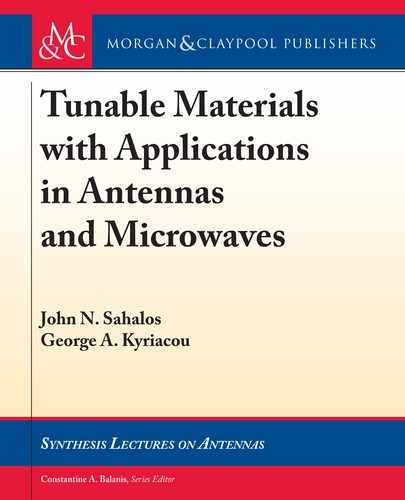32 2. TUNABLE MATERIALS–CHARACTERISTICS AND CONSTITUTIVE PARAMETERS
in MMIC fabrication processes. In general, the development of single crystal films of spinel and
hexagonal ferrites is possible, but it involves many problems in practical applications (see [11]
and the references therein). One of the most serious problems pertains to the surface quality
of spinel ferrite films. When slow cooling grows films, they tend to crystallize in the form of
an octahedron, yielding a “rough surface” with hillocks and terraces as compared to the smooth
surface of crystallized garnet films. is phenomenon results in microwave losses (increased line-
width). A lot of effort is put into magnesium spinel ferrite, Mg(InGa)
2
O
4
, and, in particular,
lithium ferrite films. e latter in principle provides low microwave losses, comparable to YIG.
It retaines the highest saturation magnetization and the highest Curie temperature.
Self-Biasing e primary interest in the effort to develop single-crystal hexagonal ferrites is
stimulated by their self-biasing capability (due to the large built-in magnetic field) and their high
saturation magnetization. ese features make them very attractive for mw applications. BaM
hexaferrite (BaFe
12
O
19
), in particular, has attracted the attention of LPE (liquid phase epitaxy)
film growers (see [11] and references therein). However, more research effort is required toward
their practical exploitation.
2.4.2 POLYCRYSTALLINE FERRITE FILMS
Even though monocrystalline ferrite films constitute the main target, current research has
achieved the fabrication of mw and mmw components such as circulators, isolators, and phase
shifters. is employs thick film polycrystalline ferrite technology (see [11, 19] and original ref-
erences therein). Note that films with thickness of 1 m are considered to be thin films, while
films with thickness of the order of 30–35 m are regarded as thick films.
2.5 FERRITE FILMS AND MMIC COMBATIBILITY
e main problems associated with the deposition of ferrite films on semiconductor substrate,
aiming at a monolithic microwave circuit, stem from the thermal expansion mismatches between
the film and the substrate. is is particularly evident in the high temperatures required for
post-deposition annealing in order to crystallize the amorphous phases of ferrites [11, 19]. For
example, temperatures of the order of 250
ı
C may damage parts of the MMIC circuit. However,
alternative configurations may solve this compatibility problem. According to Glass [11], it is
possible to use oxide substrates, which are appropriate for the preparation of epitaxial GaAs
films and for the deposition of ferrite films, even single-crystal ones. In this manner, a single
MMIC may be composed of “active semiconductor” and “ferrite film” islands. ese regions
could be incorporated into optical or acoustical circuits. A significant research effort toward this
direction has been activated; the GGG and Si are tried as common substrates (see references
in [11]).
Another compatibility problem of ferrite circuits and MMICs stems from the external
DC biasing magnetic field. is gets more serious as the frequency of operation increases, es-
..................Content has been hidden....................
You can't read the all page of ebook, please click here login for view all page.
